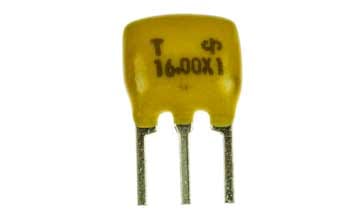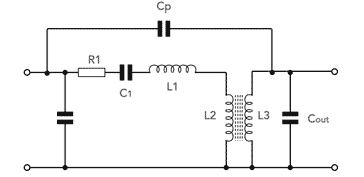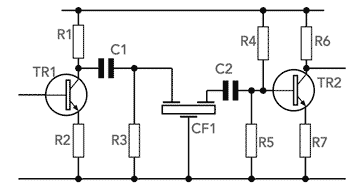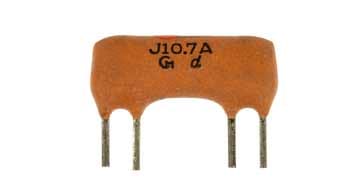Ceramic Filter & Resonator: RF & IF Bandpass Filter
Ceramic filters use piezoelectric ceramic elements to provide low cost, compact alternative electronic component to LC or quartz crystal RF filters for many radio frequency or RF circuit designs, particularly as IF filters.
Home » Electronic components » this page
Quartz Crystals, Xtals Tutorial Includes:
Quartz crystals: xtals
What is quartz
How a crystal works
Crystal overtone operation
Quartz crystal frequency pulling
Quartz crystal cuts
Quartz ageing
Crystal resonator manufacture
How to specify a quartz crystal
VCXO
TCXO
OCXO
Crystal filter
Monolithic crystal filter
Ceramic resonator & filter
Ceramic filter specifications
Ceramic filters are electronic components that are widely used in IF and RF bandpass filter applications for RF circuit design in radio receivers and transmitters and the like. They may also be used as resonant elements in a variety of electronic circuit designs, often being used in FM demodulators.
These RF & IF ceramic filters are low cost electronic components that are easy to use and in many ways ideal for a host of applications where the performance of more costly filters such as crystal filters are needed.
In addition to their cost and performance, their size can be important because they are normally quite small, making them ideal for use in many compact modern RF designs. These resonators and filters are available both in leaded formats for traditional through hole mounting as well as in a surface mount technology format for large scale production.

RF & IF ceramic filter basics
As the name implies, RF & IF ceramic bandpass filters are manufactured from ceramics that exhibit the piezo-electric effect. One of the most common ceramics used is known as PZT,lead zirconium titanate.
These RF filters were initially available for lower frequencies, with centre frequencies typically being within the range of a few kilohertz up to frequencies of 10.7 MHz which is a standard IF for many FM broadcast receivers. However significant investment in the development of these filters enabled much higher frequencies and specification levels to be achieved. Frequencies up to UHF and beyond are now available.
Having a lower Q level than quartz, these ceramic RF & IF filters have bandwidths that are typically measured between 0.05 and 20% of the operating frequency. Often the Q levels range between around 500 up to 10 000 or possibly more as the technology improves.
| Different Types of Filter & Resonator Available for RF Designs |
||
|---|---|---|
| Filter Type | Typical Frequency Range | Details |
| Ceramic Filter | 100kHz - 100MHz | Utilise piezoelectric ceramic elements. The performance of these electronic components is much superior to that of LC RF filters, but not as good as crystal filters. Their small size and low cost lends them to use on many radio receivers of all sorts, but particularly as IF filters. They have some spurious responses. |
| LC filter | 100kHz upwards | LC RF filters are often the first type of filter that may be considered. They can be fabricated from basic inductors and capacitors making them ideal for many applications. Their performance in terms of Q, etc, is generally inferior tot hat of ceramic filters and quartz crystal filters. |
| Crystal filter | 10kHz - 200MHz | Very high performance RF filters with steep sides between passband and stopband. Very good stability and normally low loss for the performance. They have some spurious responses. |
Ceramic resonators and filters operate because the ceramics used exhibit the piezo electric effect. The ceramic element uses its very high Q mechanical resonances to provide the resonant features. As in the case of a quartz crystal, the incoming electrical signals are converted into mechanical vibrations which are affected by the mechanical resonances, and then the resulting effect is linked back into the electrical domain again.
The overall effect of the piezoelectric linkage is that the electrical signals are affected by the mechanical resonances of the ceramic element as if these resonances were in the electrical domain.
There are several different ways in which the piezoelectric ceramic resonator can vibrate. Typically different vibration modes are used for ceramic resonators operating in different frequency ranges.
| Ceramic Resonator Typical Vibration Modes & Frequencies |
||
|---|---|---|
| Vibration mode | Typical Frequency Range | Details |
| Flexural mode | Below ~ 50kHz | In the flexural mode for ceramic filters the vibration can be seen over the length of the ceramic crystal. The ends may go up and down whilst the middle will go down and up. |
| Length mode | ~50kHz - 1MHz | When this vibration mode is used for ceramic resonator elements, the length of the element vibrates, extending and shortening over the course of the vibration. |
| Area expansion mode | ~100kHz - 2MHz | For this vibration mode the area of the flat ceramic resonator plate expands and contracts in all directions in line with the vibration. As the area increases, so the thickness reduces slightly. |
| Thickness shear mode | ~ 1MHz - 25MHz | In this mode the vibration ocurs across the thickness of the ceramic resonator blank. It appears as a shearing action, and vibrations can be seen across the thickness of the resonator. |
| Thickness expander mode | ~1MHz - 10 MHz | This vibrational mode for a ceramic resonator may appear unusual. The vibration appears mainly int he centre of the blank and the thickness appears to vibrate becoming thicker and thinner in the centre with the vibrational wave being seen less towards the edges. |
It is helpful to have an understanding of the basic operation of ceramic filters so that they can be used most effectively in any RF circuit design applications.
Ceramic resonator formats
Ceramic filters and resonators are available in two basic forms:
Basic ceramic resonator: The basic ceramic resonator has two connections and it is the equivalent of a single quartz crystal. It is used in a variety of applications where a single low cost resonator is required.

Leaded ceramic resonators showing the two connection pins Ceramic filter: Ceramic resonator technology can also be used in electronic circuit design to provide a bandpass filter. The filters have three connections rather than the two used for the basic ceramic resonator.

Leaded ceramic passband filters showing the three connection pins - input, output, common
These electronic components are available in both leaded formats as well as SMDs, surface mount devices.
More details about each of the two main types of ceramic resonator technology are given below.
Basic ceramic resonator
The ceramic resonator itself is a basic two terminal electronic component which has many similarities to a single crystal, although the level of performance is not as high. However the ceramic resonator has the advantage that it is a much lower cost electronic component, and is therefore more applicable to mass produced RF circuit design applications.
In terms of the circuit symbol, the same circuit symbol as that used for a crystal is used:- it depicts a ceramic crystal being held between two plates.

In terms of its physical realisation, this elemental ceramic resonator has electrodes plated onto either side of the ceramic itself. In terms of its performance, it behaves in much the same way as a single quartz crystal, although with a lower level of performance. Also the separation between the parallel and series resonant frequencies is greater.

The ceramic resonator has electrodes plated onto either side of the element to enable the electrical signals to be placed across the piezoelectric element.
It is often useful to represent the ceramic resonator in terms of its equivalent electrical components. For the ceramic resonator, the circuit is very similar to that of a quartz crystal, although the actual equivalent values are different, representing the different performance.

The basic equivalent circuit is the same as that for a standard quartz crystal. The different elements are termed:
C1 = equivalent compliance
L1 = equivalent mass
R1 = equivalent resistance
C0 = parallel equivalent capacity
These elements are all seen as electrical values when used within an electronic circuit. Also the series resistance represents the losses in the circuit, the lower the value the lower the losses and the higher the value for Q.
From the equivalent circuit, it can be seen that the ceramic resonator has both series and parallel resonances in the same way that a quartz crystal does. The main difference is that these resonances have a greater separation in the case of the ceramic resonator.

The impedance curve for the ceramic resonator shows a peak value of impedance at the parallel resonance point, and a minimum at the series resonance point.
It is possible to relate the series and parallel resonant frequencies to the circuit values shown in the diagram:
Parallel resonant frequency
Series resonant or anti-resonant frequency
Ceramic filter: ceramic bandpass RF filter
The ceramic bandpass filter is used in many radio receivers, where it is able to replace all the LC transformers with a single electronic component. Being a relatively low cost electronic component itself, this has many cost advantages, whilst also maintaining the level of performance.

Typically there are three connections, although sometimes more are used. The three main connections are: input, output and common which is normally taken to ground. When four connections are used, two are for the input and two for the output - typically two pins are taken to ground. However the four pin option gives the option for the input and output "ground" connections to be at different potentials.
The ceramic filter circuit symbol gives a representation for the ceramic resonator together with the common electrode at the bottom, and the input and output electrodes separated in distance across the ceramic resonator element itself.

Like the two connection ceramic resonator, the three connection ceramic filter it is possible to generate an equivalent circuit in terms of the basic inductors, capacitors and resistors that might be needed to recreate the RF filter.

It must be remembered that unlike a transformer style LC RF filter used for inter-stage coupling and tuning, there is no DC path within the ceramic filter - it is an insulator. Therefore any circuit using ceramic filters must take account of this providing all the bias and source current from outside the filter. A transistor circuit if the format shown below would work, although many IF amplifier or complete radio ICs have ports specifically for use ceramic filters and will incorporate the correct current and bias paths outside the ceramic filter.

and showing DC arrangements
The other point to note is that the ceramic filter needs to have the correct source and load impedances if it is to operate correctly. It is often not quite so easy to arrange the exact impedance from the circuit driving the filter, and accordingly the resistor R3 has been included to ensure that the correct source impedance is seen. For the output, it is relatively easy to adjust the values of the potential divider to provide the required load impedance. If this caused the current drain to be too high, then a resistor could be placed between the capacitor C2 and the filter to ground.
Ceramic IF filter specifications
When undertaking any RF circuit design using a ceramic RF or IF filter, it is essential to understand the specifications. Not only are there parameters such as the bandwidth, in-band ripple, insertion loss, centre frequency, and the like that are related to the filtering characteristics, but issues like input and output impedance as well as group delay and the like, are all important.

Accommodating the various parameters so that the circuit and the filter operate together is a key aspect of any electronic circuit design. Selecting the right RF filter from the specifications and datasheet, etc is an essential element ont he circuit design of the final product.
Ceramic filters and resonators are widely used as cheap RF and IF bandpass filters for a variety of RF circuit design and other electronic design applications. These RF filters are available directly from the manufacturer, but normally in very large quantities, or via an electronic components distributor.
Initially ceramic filters were primarily used to provide IF selectivity in low cost broadcast receivers. Now the technology has improved significantly and they are widely used at much higher frequencies and to meet more exacting requirements. Accordingly they are used in many forms of RF designs ranging from radio systems for communications purposes, cellular or mobile communications to wireless applications as well as in broadcast radios, televisions and other more traditional RF design applications.
 Written by Ian Poole .
Written by Ian Poole .
Experienced electronics engineer and author.
More Electronic Components:
Batteries
Capacitors
Connectors
ADC
DAC
Diodes
FET
Inductors
Memory types
Phototransistor
Quartz crystals
Relays
Resistors
RF connectors
Switches
Surface mount technology
Thyristor
Transformers
Transistor
Unijunction
Valves / Tubes
Return to Components menu . . .


